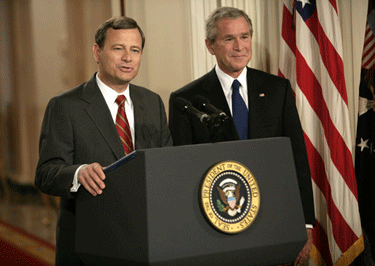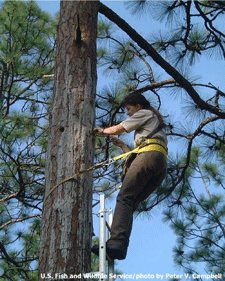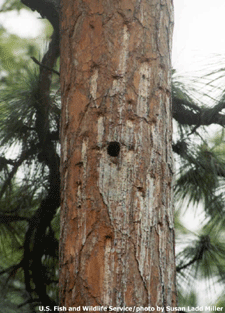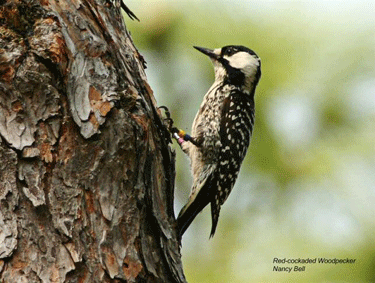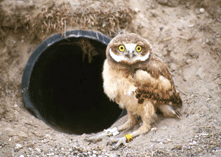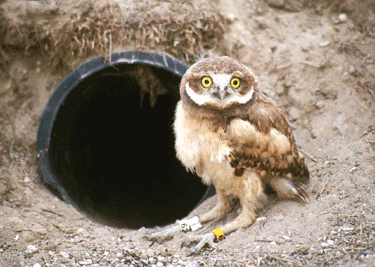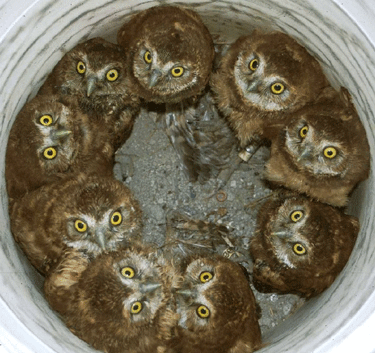September 16, 2005
Air Date: September 16, 2005
FULL SHOW
SEGMENTS
Judge Roberts Takes the Stand
View the page for this story
He could soon be the Supreme Court's new Chief Justice. What do we know about Judge John Roberts when it comes to protecting the environment? Host Steve Curwood talks with legal analyst John Turley about what we learned from the judge's hearings. (12:00)
Katrina After-effects
View the page for this story
Cleaning up after Katrina will be a lengthy and expensive task. The EPA is taking the first steps in this process by sampling air and water in New Orleans. Critics say the cleanup could suffer from a lack of financial and scientific resources within the agency, but Administrator Stephen Johnson says the EPA is up for the challenge. (03:00)
Lessons from 9/11
View the page for this story
New York resident Kimberly Flynn has some advice for the citizens of New Orleans: take the EPA's word with a grain of salt. Flynn lived through the terrorist attacks on the World Trade Center, and afterwards confronted the EPA multiple times about the contaminated dust left behind in many residential apartments. She talks with host Steve Curwood about lessons the EPA should learn from 9/11. (05:10)
Call for Oil Refineries
View the page for this story
With the shutdown of oil refineries on the Gulf Coast and the resulting run-up in oil prices, some, including members of Congress, are asking if we should be building more oil refineries in the US. Robert Slaughter, president of the National Petrochemical and Refiners Association, talks with host Steve Curwood about what, if anything, we can do to get ourselves out of this oil crisis. (04:20)
Hola CAFÉ
/ Ingrid LobetView the page for this story
The waves rippling out from New Orleans could mean another look at vehicle mileage standards. Following Hurricane Katrina, some new senators and lobby groups are saying it's time cars and trucks got better mileage. Living on Earth's Ingrid Lobet reports. (03:30)
Emerging Science Note/Salt-Resistant Rice
/ Jennifer ChuView the page for this story
Living on Earth's Jennifer Chu reports on an ancient strain of rice that could make much of China's unusable land arable. (01:20)
A Tune-up for the Endangered Species Act?
/ Jeff YoungView the page for this story
One of the Endangered Species Act's harshest critics is leading the Congressional effort to re-write the Act. Living on Earth's Jeff Young explores some of the rhetoric and ideas on changing this landmark law. (12:00)
Digging for Owls
/ Jeff RiceView the page for this story
The rare burrowing owl lives underground and has numerous vocalizations, including a call that mimics rattlesnakes to scare off predators. From southern Idaho, producer Jeff Rice reports on his trip with a biologist to dig for the tiny owls. (04:30)
Show Credits and Funders
Show Transcript
HOST: Steve Curwood
GUESTS: Jonathan Turley, Kimberly Flynn, Robert Slaughter
REPORTERS: Ingrid Lobet, Jeff Young, Jeff Rice
NOTE: Jennifer Chu
[THEME MUSIC]
CURWOOD: From NPR, this is Living on Earth.
[THEME MUSIC]
CURWOOD: I’m Steve Curwood.
With environmental case law and legal precedents at key cross roads, some looked to the confirmation hearings of Chief Justice nominee John Roberts for a sense of how he would deal with environmental protections.
Many praised Judge Roberts, but others felt shortchanged in the process.
TURLEY: There has been zero information, in my view, exchanged during these hearings. They’ve been a virtual cure to insomnia.
CURWOOD: Also, collaboration instead of confrontation - how to do the Endangered Species Act better.
JOHNSON: Now that I know I'm not gonna be penalized or face any undue restrictions by their presence on the land we're glad to see birds here now and we're happy to show others what we've done and making a visible difference in trying to save an endangered species.
CURWOOD: We’ll have those stories and more, this week on Living on Earth. Stick around.
[NPR NEWSCAST]
[MUSIC: Boards of Canada “Zoetrope” from ‘In A Beautiful Place Out in the Country’ (Warp Records – 2000)]
[THEME MUSIC]
ANNOUNCER: Support for Living on Earth comes from the National Science Foundation and Stonyfield Farm.
Judge Roberts Takes the Stand
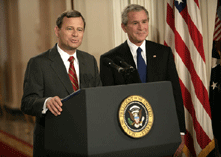
John Roberts with President Bush, July 2005 (White House photo by Eric Draper)
CURWOOD: From the Jennifer and Ted Stanley Studios in Somerville, Massachusetts, this is Living on Earth. I'm Steve Curwood.
The Judiciary Committee of the United States Senate is expected to vote shortly on whether Federal Appeals Judge John Roberts should be the next Chief Justice of the United States Supreme Court. A vote by the full Senate is expected to follow.
Judge Roberts recently fielded Judiciary Committee questions for the better part of three days, and many of those questions had to do with the core legal issues underpinning environmental regulation and legislation.
We’ve asked law professor Jonathan Turley to help us better understand those issues and what—if anything—we learned about Judge Roberts on the environment. Mr Turley is the Shapiro Professor of Public Interest Law at George Washington University and joins us from his office in Washington, DC. Professor Turley, welcome to Living on Earth. TURLEY: Thanks. Good to be back. CURWOOD: You know, it didn’t take long for Senators to get to the environment in this hearing. The ranking Senate Democrat on Judiciary, Pat Leahy of Vermont, had a question in his very first round with Judge Roberts concerning something called “standing” and whether ordinary citizens should be able to bring environmental lawsuits. Why do you think that Senator Leahy put such importance on this issue? And what is standing anyway? TURLEY: Well, Senator Leahy asked the right question because many citizens don’t understand that no matter how good your laws may be, no matter how pro-environment and protective they may be, they mean nothing unless people can actually get into court and bring lawsuits under those laws. That’s a question of standing. A citizen has to show that she has a right to bring a case before a court. That requires a showing of some injury and this notion of legal standing to qualify her, essentially, as a bona fide litigant. In the last twenty years, the federal courts and Congress, to some extent, has been narrowing the principle of standing. Chief Justice Rehnquist has been particularly aggressive in narrowing the definition of standing and, thereby, reducing the access to the courts of some citizen groups and individual citizens. CURWOOD: And, of course, the environment is an issue where almost anyone can claim they might be affected by something. I mean, if air is being polluted somewhere, anyone could breathe that air and they might be justifiably concerned about it. TURLEY: That’s right. And we went through a period where citizens were given a much more liberal treatment in bringing cases. And there was, in fact, a very significant case called Sierra Club v. Morton where the court actually debated whether trees and animals have standing; whether you can bring a lawsuit essentially on behalf of a forest. But those times are long gone. One of the principle things that the Rehnquist court worked on so ardently was to reduce standing and reduce access to the courts. John Roberts appears to be cut from that same cloth as Chief Justice Rehnquist. CURWOOD: So, what can we look at in the courts now? I would think that also Supreme Court Justice Antonin Scalia is pretty sensitive to this idea, as well. TURLEY: Yes, indeed. Scalia has been one of the great advocates in reducing standing, reducing access to the courts. I personally believe that John Roberts is very much like Scalia and Rehnquist in their views. CURWOOD: Now, there’s an article that Judge Roberts wrote for the Duke University Law Journal defending this perspective. And I’d like to play some tape of how Senator Leahy took Judge Roberts to task on that. [HEARING TAPE:] LEAHY: So I ask you this: If peoples, if their president or their governor fails to enforce these laws, why shouldn't individuals have access to courts where polluting companies could be made to pay for their wrongdoing? What can you do to assure us that they as individuals won't find under a Chief Justice Roberts, find the courthouse door slammed shut in their face? ROBERTS: Well, one thing I would tell them to do is read the rest of the Duke Law Journal article. Because one thing, one point it makes is that environmental interests, it goes on to say, aesthetic interests, those are all protected under the law, and that one reason courts should insist that those who bring suit have standing -- that's the issue, that are actually injured – is because standing can encompass, certainly, environmental harms. The issue that was being addressed in the Duke Law Journal article was whether anyone could bring a lawsuit just because they're interested in the issue, or whether the plaintiffs had to show that they had been injured. The question is whether somebody halfway across the country who's not injured by that act should be able to bring suit. CURWOOD: So, what do you think the answer to that question might be from Judge Roberts if he were here and with us and willing to answer directly? TURLEY: [LAUGHS] Well, the directly point is the difficult one. I think, frankly, that answer was colossal spin. I have read the 1993 Law Review article and what comes out of there, in my view, is a very strident voice in terms of reducing access to the courts and reducing standing. At one point, he says that we can’t allow federal courts to be occupied by lawsuits, and this is a quote “at the behest of any John Q. Public who happens to be interested.” Well, that reflects the same view of Scalia and Rehnquist that simply bringing forth a legitimate case involving a violation in the environment is not enough. You have to show what’s sometimes called “user standing” that you are personally injured to bring the suit. Well, some of these lawsuits, particularly the extra-territorial suits—the ones occurring outside the country—make that very, very difficult CURWOOD: So, if a wetlands advocacy group from, say, Massachusetts looked at the situation in southern Louisiana and said the destruction of the wetlands there is really endangering the people of New Orleans, and activities, certain government activities should stop, they wouldn’t be able to bring such a lawsuit. TURLEY: That’s right. Or if you have people who want to stop the loss of an endangered species, or the destruction of a forest, they need to show something other than the mere fact that the statute’s being violated. Now, all courts agree that you have to have some limitations on standing. There was a time when we debated the concept of “universal standings”—simply allowing people to come in and sue whenever they see these violations. That view was rejected. But what John Roberts has advocated in the past is a much more stringent test, one that requires such an injury that it excludes the vast majority of citizens who are inclined to sue in a given case. CURWOOD: All right now, let’s look at his judicial record. He’s only been on the bench now for a couple of years in the federal appeals courts. There’s not a lot of court opinion upon which to judge the judge here. There is one big environmental opinion that he has. That involves an endangered species case. Officially, it’s the Rancho Viejo case but because of Roberts’ own colorful opinion it’s known as “the hapless toad” case. What’s that about, Professor Turley? TURLEY: [LAUGHS] Well, Judge Roberts referred to this protected species as “the hapless toad” that unfortunately lives its life in California and does not cross state lines. And the reason it’s “hapless” is it would have been better if it travelled a little more. If it got over state lines, it would clearly trigger interstate commerce, one of the grounds with which Congress can regulate and protect thing like the hapless toad. CURWOOD: Now, maybe because this was a California case, California Democratic Senator Diane Feinstein asked Judge Roberts about it. Let’s listen to a bit of that exchange: [TAPE FROM HEARING] ROBERTS: I did not take the position that it was outside the scope of the commerce clause. It was a question of which ground under the commerce clause we ought to look at. FEINSTEIN: There's a great deal of concern as to what this then means for the implication for all environmental law--the Clean Water Act, the Clean Air Act. But if I understand you correctly, what you’re saying is that you do not believe that the commerce clause should prohibit legislation in this area. Is that correct? ROBERTS: I have not had occasion to decide that. I did not decide it in the Rancho Viejo case. One of the other judges did, and I did not join that opinion. What I said is: we should consider these other grounds. Those other grounds were what other courts had used to sustain application of the Endangered Species Act in the cases that came before them. They analyzed the protection of the endangered species as implicating a commercial activity. And that allowed them to sustain the act without regard to whether it had an interstate effect itself. CURWOOD: So, we didn’t still get quite a full view of what’s in Judge Roberts’ hand on this issue, did we, hmm? TURLEY: [LAUGHS] No. It’s moments like this that you really miss Bob Bork. I mean he would’ve just basically said “I feel free to wear a necklace of hapless toads into this room. I am not going to accept the commerce clause protects it.” In the decision, John Roberts sounds much more strident than he appeared in that committee room. He said in that opinion that he chastised the panel’s approach because it suggested, and here’s the quote: “the taking of a hapless toad that for reasons of its own lives its entire life in California constitutes regulating commerce.” Well, the clear message there was that he didn’t agree with that position. Now, he might have found, as he suggested in the hearing, other grounds to support the federal regulation. Well, what seems abundantly clear from that statement, and from his earlier writings, is that he does not believe that the commerce clause authority of Congress is a likely basis to protect endangered species or, presumably, other environmental regulations. CURWOOD: And just to remind people that Robert Bork, of course, was famously rejected as a Supreme Court nominee after being fairly explicit about his conservative views in front of the Congress that was holding hearings. And other Supreme Court Justices since that time have also been fairly explicit about their views. This time around, it seems like there are not a lot of questions being answered clearly. TURLEY: Yeah, I’m not too sure what is going on. We can all disagree with what the framers intended these meetings to be but I can’t believe that this is what they intended it to be. There has been zero information, in my view, exchanged during these hearings. They’ve been a virtual cure to insomnia. But, you know, what’s strange is that the Democratic Senators while complaining, they don’t seem to be organized in a serious opposition. You know, John Roberts’ views are not unlike Bob Bork’s! And many of these Senators laid down in front of Bob Bork and said “over my dead body will you make it to the Supreme Court.” Well, if you shave off the beard and give a few Botox injections, you have John Roberts on issues like commerce clause and affirmative action. So, what I find really striking is not just that the Roberts’ model is gonna gut future confirmation hearings in terms of their substance. But also it shows how purely visual American politics really have become. CURWOOD: Jonathan Turley is the Shapiro Professor of Public Interest Law at George Washington University. Thanks for your time. TURLEY: It’s my great pleasure. [MUSIC: Radiohead “Like Spinning Plates” from ‘Amnesiac’ (Reprise - 1998)] CURWOOD: Coming up: the environmental aftermath of Hurricane Katrina. The EPA says the scale of the disaster marks new territory for the agency. Keep listening to Living on Earth. [MUSIC: Pavement “5 Minus 4 Equals Unity” from ‘Crooked Rain, Crooked Rain’ (Matador 2004)] Katrina After-effectsCURWOOD: It's Living on Earth. I'm Steve Curwood. Louisiana is one of the nation’s most important sites for the chemical and oil industries, but in the first few days after Hurricane Katrina, there was little information available about any toxic hazards the storm might have unleashed. That’s because the Environmental Protection Agency says crews it dispatched at first joined the search and rescue efforts, rather than testing the air and water. Now, the EPA has turned to its core mission: protecting the future of these Gulf Coast communities from lasting environmental damage. And preliminary test results aren’t promising. According to the agency's air and water sampling, New Orleans floodwaters contain significant amounts of arsenic, lead and hexavalent chromium - a human carcinogen found in plastics and paints. There are also substantial quantities of E. coli and other bacteria that pose serious health risks. Meanwhile, air samples show high levels of an acid found in detergents and pharmaceuticals that can cause skin injuries, respiratory problems and nervous system damage. Other air monitors have detected freon, isobutylene, and methanol but, so far, the EPA is not reporting that these are at dangerous levels. EPA Administrator Stephen Johnson says the challenge his agency faces is huge. JOHNSON: This really is unchartered territory. Unchartered territory in the sense of the magnitude of the problem. In my 25 year history here at EPA, have never seen the kind of historic disaster, natural disaster that we're facing, and EPA is there to help. CURWOOD: But it’s hard to know how much help will be required from the EPA, and how much more work it can handle. The agency has been hit repeatedly by the Bush administration’s budget axe, with reductions scheduled for this year and next. The added costs of assessing Katrina’s damage, and implementing restoration and remediation could easily put the EPA in the red but, so far, Administrator Johnson isn’t worried. JOHNSON: At this point, we have sufficient funds; we're in the early days of assessment and we don't know what that assessment will show. Certainly, I've instructed our staff if there are any resource issues to make them known to me immediately. But, for now, we have sufficient resources to do what we are doing. CURWOOD: As residents return to the city, critics of the EPA warn there may be political pressures on the agency to sound the “all-clear” and allow rebuilding while there is still widespread contamination. Steve Johnson dismisses those worries. JOHNSON: I have not faced any pressure whatsoever. My responsibilities as head of EPA is to make sure the public health and environment are protected and, certainly, I've taken all the steps necessary to do that by doing all the sampling we're doing, by providing advice and council when I was alerted. When I was briefed that the water was unsafe, then Dr. Gerberding of the CDC and I went on national news to try to get the message out this water's unsafe. So my responsibility is to make sure public health and the environment are protected, and that's what I intend to do. CURWOOD: The EPA administrator went on to say the agency has learned many lessons from its response to the World Trade Center disaster, and the priority now is on getting information out to the public as test results come in. The agency was widely criticized for downplaying air quality results in the early days after 9/11, and providing inadequate cleanup in the aftermath.
Lessons from 9/11CURWOOD: One of the critics is Kimberly Flynn, a 9/11 survivor , and co-coordinator of the 9/11 Environmental Action Group in Lower Manhattan. She’s also a native of New Orleans and she joins me now from New York City. Hello. FLYNN: Hello, thanks for having me. CURWOOD: Let me ask you, you've had many meetings with the EPA about their disaster response after 9/11. What was the quality of your overall experience with them? FLYNN: Well, it was an experience of struggle. My group and the community groups and labor groups that went into these meetings at EPA Region 2 in the summer of 2002, brought to EPA many recommendations for important improvements to EPA's testing and cleanup protocols. EPA, unfortunately, ignored our recommendations, and then, in 2003, the EPA's Inspector General released its report on EPA's environmental response, and lo and behold, every recommendation that we had made was in the IG report Chapter 6 on the indoor cleanup. We were right, the EPA was wrong. CURWOOD: Now, you were trying to make your neighborhoods habitable again. What was the problem with the EPA? They weren't testing the right things? They weren't making the right recommendations? What did you want them to do? FLYNN: Well, what we wanted them to do was something called “representative testing.” We wanted them to do testing in buildings successive perimeters around Ground Zero. So you test around Ground Zero, and then you move out to the next circle and you test inside buildings there, and you test and look for the point at which contaminants, like lead and asbestos and mercury and other things in the World Trade Center dust, drop off significantly. EPA never conducted representative testing. We also wanted EPA to offer a sound, comprehensive cleanup of all residences and workplaces that were affected by the disaster. EPA, instead, offered a voluntary cleanup for apartments only, it did very little outreach, and the cleanup was very substandard. In the end, fewer than 18 percent of, I think, 30,000 apartments in Lower Manhattan were even touched by the EPA. CURWOOD: So now, as you look at what's going on in New Orleans as far as the EPA's response to the hurricane, how do you feel about how it's doing its job? FLYNN: Troubled. We’re actually very worried that we’re watching another cover up shape up. CURWOOD: Cover up? That’s strong words. FLYNN: Yeah, I know it is but, really, when we look at EPA's testing design for floodwater in New Orleans, EPA started out with six sites where they were doing water sampling. Now it's expanded to 13 sites. But New Orleans is 180 square miles of land and 80 percent of that was underwater. So this raises the question of whether EPA is using adequate sampling methodologies, or whether in fact EPA is looking to find as little as possible so that it has to conduct as little cleanup as possible. CURWOOD: You have family in New Orleans, I understand it, still. Where were they when the hurricane struck? FLYNN: My family was in an apartment building in the near vicinity of the now-notorious 17th Street Canal levee break. CURWOOD: How did they do? FLYNN: They did fine. The winds were extremely scary, and they were actually, you know, they were very concerned when the floodwaters started to rise late Monday. But, eventually, they were rescued by first responders, and they are now safe and sound. We’re very lucky. CURWOOD: What's your advice to them about going back to the city? FLYNN: Well, my advice to them right now is not to go back to the city. And you know, New Orleanians love the city and New Orleanians want to come back, but right now, the city is far too contaminated. CURWOOD: In your view, the EPA didn't do a very good job in communicating with the public after 9/11 in New York. What should they do now in New Orleans? FLYNN: Well, EPA actually has even a legal obligation to do everything in its power to engage the affected communities. And we know that New Orleans is a diaspora right now and people are displaced, but they are clustered in nearby cities like Baton Rouge and Houston. So if EPA were to take seriously that it has to partner with the community, it would hold a series of town halls in these cities that should be broadcast on TV and the Internet. The public needs to get a chance to question the EPA and what we've learned from experience is that that's the fastest way to get to the bottom of any situation that involves toxics. CURWOOD: Kimberly Flynn is co-coordinator of the 9/11 Environmental Action Group in Lower Manhattan. She's also a native of New Orleans. Thanks for your information, Kim. FLYNN: Thank you very much. [MUSIC: Portishead “Roads” from ‘Dummy’ (UMG Recordings – 1994)] Call for Oil RefineriesCURWOOD: Nearly half of America's oil refineries are along the Gulf Coast between Texas and Alabama. So when Hurricane Katrina took a number of them off line, drivers immediately felt the impact with record gas prices, as there were no other refineries to take up the slack. No new refineries have been built in the U. S. since the 1970’s, and many of the older and dirty ones have been retired. Now some say we need more refineries, built to strict clean standards. Among them is Robert Slaughter, he’s president of the National Petrochemical and Refiners Association. Mr. Slaughter, why do we need new refineries? SLAUGHTER: Well, basically, because we have been unable to keep up even with the growth in demand in the United States for most of the last ten years. The number of refineries and the refining capacity peaked in 1981 at the end of the price control period. Some refining capacity has been added back over but we still have demand for well over 20 million barrels a day of product and we only have 17.1 million barrels of capacity in the United States. CURWOOD: I’m confused here. If there’s so much demand why are we short of refining capacity? If your industry can sell a lot of gasoline why won’t folks have the plants to refine it? SLAUGHTER: Well, it’s very difficult to build heavy industrial facilities in the United States. It’s very difficult to get through the permitting process and to get new refineries built. We’ve been adding capacity at existing refining sites but there have been times over the last ten years when that has been difficult to do. The other factor that’s been very important is that for the past 15 years before 2003 the return on investment in refining was very small. It is only in the past two years when refining margins have improved and we think we’re going to see a big uptick in refining investment this year. But that just was not the case in the last several years and it takes a few years to bring capacity online. CURWOOD: Why is the refinery business so highly regulated? SLAUGHTER: Well, you know, there are a number of environmental restrictions that come out of the Clean Air Act; there are also the Clean Water Act and, you know, it’s just the refining industry has always been very pervasively regulated and most of the regulations are environmental. CURWOOD: As I understand it, environmental critics of the refining industry say that these new refineries, in fact, would be pretty clean. Is that a fair assessment? SLAUGHTER: Yeah, I believe all of us would agree that new refineries would be pretty clean and, of course, even the existing refineries have considerably improved their environmental performance with newer technologies that have been installed. But the new refineries, unfortunately it is very difficult to build these facilities in the U.S., would be the cleanest of all. CURWOOD: I understand that some folks would like to see the environmental regulations relaxed for a refinery. That, in fact, maybe a federal rule imposed over the matrix of state rules that now govern it. How do you feel about that? SLAUGHTER: What people are talking about is that the permitting process for changes in a refinery, such as adding additional capacity, currently can take two years and the process could be shorter. I mean if, as Congress seems to feel now, there is a national interest in having more refining capacity in the United States, the question is whether, as Congress has just done in the case of liquified natural gas facilities, if the state permitting process is taking a great deal of time and just seems to have no end and the national interest in having facilities is not being recognized, you could give a federal department the authority of looking at that process and the determinations in deciding whether it should grant the permit. CURWOOD: Bob Slaughter is president of the National Petrochemical and Refiners Association in Washington, DC, Bob, thanks for taking this time with me today. SLAUGHTER: Thanks for the opportunity, I appreciate it. Related links: [MUSIC: Colleen “The Golden Morning Breaks” from ‘The Golden Morning Breaks’ (Leaf Label – 2005)] Hola CAFÉCURWOOD: There’s a new theme in the auto showroom these days: gas mileage. LOBET: Just over a month ago, Congress concluded a years-long effort, setting the country's energy direction. It opted mainly to encourage more oil and gas production and not to force automakers to produce more fuel-efficient cars and trucks. After that energy bill was signed, the Bush administration veered gently toward conservation, with a plan to require light trucks and SUVs to get better mileage. Then came Hurricane Katrina. Representatives Edward Markey and Sherwood Boehlert saw an opening and reintroduced a fuel efficiency bill that's been slowly gaining support for four years. BOEHLERT:: It would raise federal fuel efficiency or CAFE standards for cars and trucks from today's average of 25 miles per gallon, to at least 33 miles per gallon over the next 10 years. LOBET: Members of Congress are hearing from constituents angry about fuel prices. Senator Pete Domenici is chair of the Energy and Natural Resources Committee. DOMENICI: I believe we must take another look at CAFE standards. We looked at ‘em and they were an impossibility because of the politics of it. I’m not sure that will be the case after Katrina LOBET: "CAFE" is short for corporate average fuel economy. Each carmaker, like GM and DaimlerChrysler, averages the fuel efficiency of all the cars it sells. For SUVs and light trucks, it must be no less than 21 miles per gallon and for cars--no less than 27.5. Senator Domenici's opinion rings loud because he used to oppose stricter mileage mandates. And there are other new voices joining the miles per gallon chorus. AAA, the 48 million member consumer organization, has often opposed pollution control measures, and laws that would force change on carmakers. But CEO Robert Darbelnet says its time to increase vehicle mileage. DARBELNET:: We clearly need more fuel efficient vehicles if we are going to be less reliant on what is a limited quantity of refined gasoline, and one of the ways of doing that is encouraging manufacturers to make more fuel efficient vehicles. LOBET: AAA wants the very heaviest passenger vehicles regulated. Vehicles in this class, like Hummers, currently violate no standard if they get 10 miles to the gallon. So, what are the chances that Congress will pass stricter fuel economy standards? David Jenkins of the group Republicans for Environmental Protection says it often depends on the lawmakers from prime car country--Michigan. JENKINS: The Democrats are lobbied by the labor unions that represent the automobile industry and the Republicans are lobbied by the automobile industry themselves. LOBET: A change in mileage standards could also depend on what happens with offshore drilling. There’s increased pressure for drilling right now, but it’s currently banned except off the Gulf Coast. Senator Domenici and others suggest there might be a tradeoff—higher fuel performance in exchange for the chance of drilling miles offshore New Jersey, California and Florida. For Living on Earth, I'm Ingrid Lobet [MUSIC: Patty Griffin “Reprise” from ‘1000 Kisses’ (ATO – 2002)] CURWOOD: Just ahead: A major re-write of the Endangered Species Act is under way on Capitol Hill, but not everyone agrees on the language going into it. First, this Note on Emerging Science from Jennifer Chu. [SCIENCE NOTE THEME MUSIC] Emerging Science Note/Salt-Resistant RiceCHU: The Chinese have grown rice for more than 4,000 years. In several Asian languages the words for rice and food are identical. We don’t know what the original rice plants looked like, or what their genetic makeup was, but today there are thousands of different strains. Rice is China’s major staple crop but, over the years, agricultural development and the use of pesticides and fertilizers have made much of China’s land too salty to farm. About 20 million acres of Chinese soil have salt levels that make the soil poisonous for crops. With rising population and industrial development, these areas are expanding. But scientists may have come up with a solution: salt-resistant rice plants. At the State Key Lab of Plant Molecules in Shanghai, scientists have successfully cloned a gene from an ancient variety of salt-resistant rice native to the Shanghai region. When rice grows in salty soil, natrium hydronium, a variety of salt, accumulates in the stalks and leaves and kills the plant. But, the cloned gene boosts circulation of natrium down into the plant’s roots, allowing more nutrients to flow up. If this gene can be successfully cultivated in plants, all that highly salinized land could be put to use. The results of the cloning research will be published in the Nature Genetics magazine in October, but it will be a while before we hear how the taste tests turn out. That’s this week’s Note on Emerging Science. I'm Jennifer Chu. CURWOOD: And you're listening to Living on Earth. ANNOUNCER: Support for NPR comes from NPR stations, and: The Charles Stewart Mott Foundation, online at m-o-t-t dot org, supporting efforts to promote a just, equitable and sustainable society; The Kresge Foundation. Building the capacity of nonprofit organizations through challenge grants since 1924. On the web at k-r-e-s-g-e dot org; The Annenberg Fund for excellence in communications and education; and, The W-K Kellogg Foundation. ‘From Vision to Innovative Impact: 75 Years of Philanthropy; This is NPR, National Public Radio. [MUSIC: AIR “Alone in Kyoto” from ‘Talkie Walkie’ (EMI - 2004)] CURWOOD: It's Living on Earth. I'm Steve Curwood and coming up: Owls that sound like snakes, but first… A Tune-up for the Endangered Species Act?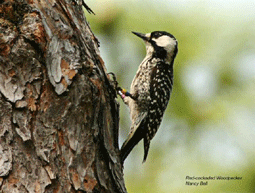
The endangered red-cockaded woodpecker. (U.S. Fish and Wildlife Service photo by Nancy Bell) CURWOOD: Three decades after Congress moved to halt the rapid decline and extinction of animal species with the passage of the Endangered Species Act, Congress is taking another look at protecting biological diversity. Some say the Endangered Species Act is broken and is in need of significant fixes, ranging from new ways to list species to different ways to protect private property rights while managing habitat. Many scientists, lawmakers and landowners all see room for improvement but so far there doesn’t seem to be much common ground in their thinking. Living on Earth’s Jeff Young explores some of the new ideas and old conflicts at work in the latest push to remake this landmark law. [NIGHT WOODS AND INSECTS]
YOUNG: You know the old saw about a bird in the hand. What’s that bird worth when it’s an endangered species? MILLER: Stay still, sweetheart. [RUSTLING OF BIRD IN NET] YOUNG: Biologist Susan Miller gently handles a red-cockaded woodpecker she’s just netted in a North Carolina pine forest. MILLER: And she’s about to just pop out of this bag. [RUSTLING] MILLER: Okay, so she’s got all color bands in place. All that’s left to do is let her go. [NIGHT WOODS AND WALKING] YOUNG: The newly banded bird skitters up a long-leaf pine to its nest cavity. Red-cockadeds are the only U.S. woodpeckers to carve their homes in living trees. It takes years. And most of their original forest habitat is gone.
Miller is part of the Fish and Wildlife Service’s effort to bring the woodpecker back from the brink of extinction. For the past decade, she’s had some help from some unlikely allies: private landowners. [TRUCK DOOR SHUTS] VOICES: Good morning. Good morning. MALE: Have you seen any red-cockadeds recently? YOUNG: Miller and a colleague visit Julian Johnson at his home on property where Johnsons have lived for four generations. They chat and watch hummingbirds and goldfinches from Johnson’s porch. There are also red-cockaded woodpeckers on his land. Not so long ago, Johnson says, a visit from federal wildlife agents would not have been so friendly. JOHNSON: We would not be so happy to see them drive up (laughs). We’d be very concerned about what they might do to, you know, restrict our activity and come in and say, “I’m sorry but you’ve got birds here, you can’t do anymore of this pine straw raking or you can’t cut this timber.” We were really worried about that and would not have been nearly so hospitable 10 or 15 years ago. YOUNG: Johnson says some landowners were clear-cutting trees to avoid what they called “infestations” of woodpeckers. But he says attitudes changed with an innovative program called Safe Harbor. Under a Safe Harbor agreement Johnson’s only responsible for the birds on the property when he signs up. He keeps his property in a state that’s good habitat for the woodpecker and when more birds show up, he doesn’t face any further property restrictions. Johnson says removing that fear and uncertainty freed him to both use his land and help the bird.
|

